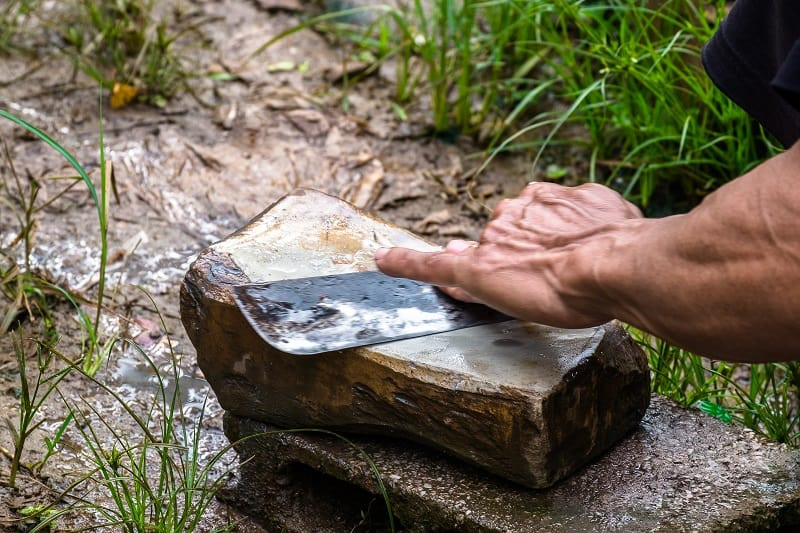Sharpening a knife on a rock is an essential skill for outdoor enthusiasts and anyone looking to maintain their blades without specialized equipment, and at rockscapes.net, we’re passionate about connecting you with nature’s resources. By mastering this technique, you not only extend the life of your knife but also gain a deeper appreciation for the art of resourcefulness. Explore the natural elegance and practicality of incorporating stone elements into your life and landscape with guidance from rockscapes.net.
1. Why Sharpen a Knife on a Rock?
Sharpening a knife on a rock offers several advantages:
- Resourcefulness: In wilderness situations or when access to conventional sharpeners is limited, a rock provides an immediate solution.
- Cost-Effectiveness: Rocks are free and readily available in many environments, making it a budget-friendly option.
- Skill Development: Mastering this technique enhances your understanding of blade maintenance and sharpens your outdoor survival skills.
- Emergency Preparedness: Knowing How To Sharpen A Knife On A Rock ensures you can maintain a sharp blade for various tasks, from food preparation to first aid.
- Connection to Nature: Using natural resources like rocks fosters a deeper appreciation for the environment and sustainable practices.
2. Understanding the Basics of Knife Sharpening
Before diving into the specifics of using a rock, it’s helpful to grasp the basic principles of knife sharpening.
2.1. The Goal of Sharpening
The primary goal is to realign the knife’s edge, which, under magnification, resembles a series of tiny teeth. These teeth can bend or become uneven with use, leading to a dull blade. Sharpening removes small amounts of metal to create a new, sharp edge.
2.2. Angle and Consistency
Maintaining a consistent angle between the blade and the sharpening surface is crucial. This angle determines the edge’s profile and sharpness. Generally, a steeper angle creates a more durable edge, while a shallower angle results in a sharper but more delicate edge.
2.3. Different Sharpening Methods
While this article focuses on using rocks, it’s worth noting other sharpening methods:
- Whetstones: Artificial or natural stones specifically designed for sharpening.
- Honing Steels: Used to realign the edge between sharpenings.
- Electric Sharpeners: Offer a quick and convenient way to sharpen knives.
2.4. Deburring
Deburring removes the tiny burr of metal that forms on the edge during sharpening. This can be done with a honing steel or by stropping the blade on a piece of leather or even cardboard.
3. Identifying the Right Type of Rock
Selecting the appropriate rock is crucial for effective and safe knife sharpening.
3.1. Key Characteristics of a Good Sharpening Rock
A suitable rock should possess the following characteristics:
- Fine Grit: A fine-grained texture is essential for creating a sharp edge without excessive abrasion.
- Hardness: The rock should be hard enough to abrade the steel of the knife but not so hard that it damages the blade.
- Flat Surface: A flat, even surface ensures consistent contact between the blade and the rock.
- Porousity: Slight porosity helps retain water, which lubricates the sharpening process and carries away metal particles.
3.2. Types of Rocks Suitable for Sharpening
Several types of rocks meet these criteria:
- Novaculite: A dense, fine-grained siliceous rock known for its excellent sharpening properties.
- Arkansas Stone: A type of novaculite found in Arkansas, USA, and widely used for sharpening.
- Sandstone: A sedimentary rock composed of sand-sized grains of mineral, rock, or organic material. Finer-grained sandstones can be effective for sharpening.
- Slate: A fine-grained, foliated metamorphic rock that can be used for honing and sharpening.
3.3. Rocks to Avoid
Avoid rocks that are:
- Too Soft: These will wear down quickly and won’t effectively sharpen the blade.
- Too Coarse: These can damage the blade and create an uneven edge.
- Brittle: These may crumble or break during use, posing a safety hazard.
- Contaminated: Rocks with dirt, oil, or other contaminants can damage the blade and hinder the sharpening process.
3.4. Finding Rocks in Your Environment
When searching for rocks in your environment, consider these tips:
- Look Near Water: Water sources often expose rocks that have been naturally smoothed and polished.
- Examine Rock Formations: Outcrops and rock formations may reveal different types of rock suitable for sharpening.
- Test the Rock: Before committing to a rock, test its hardness and grit by rubbing it against a piece of scrap metal.
- Start with a Variety: Collect several rocks with varying textures and hardness to find the best one for your knife.
 Stack of stones
Stack of stones
4. Preparing Your Rock and Knife
Proper preparation is essential for a successful sharpening session.
4.1. Cleaning the Rock
Remove any dirt, debris, or contaminants from the rock using a brush and water. Ensure the surface is clean and smooth.
4.2. Flattening the Rock (If Necessary)
If the rock’s surface is uneven, flatten it by rubbing it against another flat, hard surface, such as a concrete slab or another rock. Use water as a lubricant and continue until the surface is smooth and even.
4.3. Lubricating the Rock
Water is the most common lubricant for sharpening stones. It helps to:
- Reduce Friction: Water minimizes friction between the blade and the rock, preventing overheating and damage to the blade.
- Carry Away Metal Particles: Water flushes away metal particles that are removed during sharpening, preventing them from clogging the rock’s surface.
- Cool the Blade: Water helps to cool the blade, preventing it from overheating and losing its temper.
4.4. Preparing Your Knife
Clean your knife thoroughly with soap and water to remove any dirt, grease, or debris. Ensure the blade is dry before sharpening.
5. The Sharpening Process: Step-by-Step
Follow these steps to sharpen your knife effectively and safely:
5.1. Secure the Rock
Place the rock on a stable surface, such as a stump, a flat rock, or a piece of wood. Ensure the rock is secure and won’t move during sharpening.
5.2. Find the Correct Angle
The correct angle depends on the type of knife and its intended use. A general guideline is:
- Pocket Knives: 20-25 degrees
- Kitchen Knives: 15-20 degrees
- Hunting Knives: 25-30 degrees
To find the correct angle, visualize the blade’s edge as a wedge. The angle is the angle of that wedge.
5.3. Sharpening Strokes
Use smooth, consistent strokes to sharpen the blade. There are two main techniques:
- Push Stroke: Push the blade away from you, leading with the edge.
- Pull Stroke: Pull the blade towards you, leading with the spine.
Experiment with both techniques to find the one that feels most comfortable and effective.
5.4. Maintaining the Angle
Maintaining a consistent angle is crucial for creating a sharp, even edge. Focus on keeping the blade at the same angle throughout each stroke.
5.5. Sharpening Both Sides
Sharpen both sides of the blade equally. Alternate strokes between each side to ensure an even edge.
5.6. Checking for Sharpness
After several strokes on each side, check the blade’s sharpness. You can do this by:
- Paper Test: Try slicing through a piece of paper. A sharp blade will slice cleanly, while a dull blade will tear.
- Thumb Test: Carefully run your thumb across the blade (perpendicular to the edge). A sharp blade will feel “sticky,” while a dull blade will feel smooth.
- Visual Inspection: Examine the edge for any nicks, dents, or unevenness.
5.7. Repeating the Process
If the blade is not sharp enough, repeat the sharpening process, focusing on maintaining the correct angle and using consistent strokes.
6. Advanced Techniques and Tips
Once you’ve mastered the basic sharpening process, consider these advanced techniques and tips:
6.1. Using Different Grits
Just like whetstones, rocks can have different grits. Start with a coarser grit to remove any major imperfections and then move to a finer grit to refine the edge.
6.2. Stropping
Stropping is the process of aligning the edge of the blade after sharpening. This can be done with a piece of leather, canvas, or even cardboard. Draw the blade across the stropping surface, leading with the spine.
6.3. Micro-Bevel
A micro-bevel is a small, secondary bevel added to the edge of the blade. This can improve the blade’s durability and edge retention. To create a micro-bevel, simply increase the sharpening angle slightly for the final few strokes.
6.4. Maintaining Your Rock
Keep your sharpening rock clean and free of debris. Store it in a dry place to prevent it from cracking or deteriorating.
6.5. Experimenting with Different Rocks
Don’t be afraid to experiment with different types of rocks to find the ones that work best for you and your knives.
7. Safety Precautions
Sharpening knives can be dangerous if proper safety precautions are not followed.
7.1. Focus and Concentration
Sharpening requires focus and concentration. Avoid distractions and take breaks when needed.
7.2. Secure Grip
Maintain a firm, secure grip on both the knife and the rock.
7.3. Keep Fingers Out of the Way
Keep your fingers away from the blade’s edge. Use a sharpening guard or gloves for added protection.
7.4. First Aid
Have a first-aid kit readily available in case of accidents.
7.5. Practice in a Safe Environment
Practice sharpening in a safe environment, away from children and pets.
 man sharpening a knife with whetstone
man sharpening a knife with whetstone
8. Common Mistakes to Avoid
Avoid these common mistakes when sharpening a knife on a rock:
8.1. Using the Wrong Type of Rock
Using a rock that is too soft, too coarse, or contaminated can damage the blade and hinder the sharpening process.
8.2. Not Maintaining the Correct Angle
Failing to maintain a consistent angle will result in an uneven edge and a dull blade.
8.3. Applying Too Much Pressure
Applying too much pressure can damage the blade and cause it to overheat.
8.4. Sharpening Too Quickly
Sharpening too quickly can lead to mistakes and increase the risk of injury.
8.5. Neglecting Safety Precautions
Neglecting safety precautions can result in serious injuries.
9. How to Test the Sharpness of Your Knife
Testing the sharpness of your knife is essential to ensure it is ready for use. Here are several methods you can use:
- The Paper Test: Hold a piece of paper vertically and try to slice through it with the knife. A sharp knife will cut cleanly, while a dull knife will tear or snag the paper.
- The Tomato Test: Try slicing a ripe tomato. A sharp knife will slice through the skin without requiring much pressure, while a dull knife will crush the tomato.
- The Hair Test: Carefully shave some hair from your arm or leg. A sharp knife will easily cut the hair, while a dull knife will tug or skip over the hair.
- The Thumbnail Test: Hold the knife at a low angle and gently try to “catch” the edge on your thumbnail. A sharp knife will bite into the nail, while a dull knife will slide off.
- The Visual Test: Examine the edge of the knife under good lighting. A sharp knife will have a clean, even edge, while a dull knife will have nicks, dents, or a rounded edge.
10. Maintaining Your Sharpened Knife
Once you have sharpened your knife, it is important to maintain its sharpness. Here are some tips for maintaining your sharpened knife:
- Use a Cutting Board: Always use a cutting board when using your knife. Avoid cutting on hard surfaces like countertops or plates, as this can dull the blade.
- Wash and Dry After Each Use: Wash your knife with soap and water after each use and dry it thoroughly. This will prevent rust and corrosion.
- Store Properly: Store your knife in a knife block, sheath, or magnetic strip to protect the blade from damage.
- Honing: Use a honing steel regularly to realign the edge of the blade between sharpenings.
- Regular Sharpening: Sharpen your knife regularly, as needed, to maintain its sharpness.
11. Exploring Rockscapes.net for Stone Inspiration
At rockscapes.net, we believe in the power of natural stone to transform landscapes and enhance everyday life. Whether you’re looking for inspiration for your next landscaping project or seeking guidance on using stone in your home, our website offers a wealth of resources:
- Design Ideas: Browse our gallery of stunning stone landscapes, featuring a variety of styles and applications.
- Stone Selection: Learn about the different types of natural stone available, their unique characteristics, and how to choose the right stone for your project.
- Installation Guides: Access step-by-step guides on installing stone pathways, patios, walls, and other features.
- Maintenance Tips: Discover how to care for your stone landscapes and ensure their long-lasting beauty.
- Expert Advice: Connect with our team of experienced landscape designers and stone experts for personalized guidance and support.
12. Knife Sharpening and the Art of Landscape Design
Knife sharpening and landscape design may seem unrelated, but both involve a deep appreciation for natural materials and a commitment to craftsmanship. Just as a sharp knife enhances the culinary experience, well-placed stones can elevate the beauty and functionality of a landscape.
12.1. Stone as a Versatile Design Element
Natural stone is a versatile design element that can be used in a variety of ways to create stunning landscapes:
- Pathways and Walkways: Stone pathways and walkways add texture, character, and durability to outdoor spaces.
- Patios and Terraces: Stone patios and terraces provide inviting spaces for relaxation and entertainment.
- Walls and Retaining Walls: Stone walls and retaining walls add structure, definition, and visual interest to landscapes.
- Water Features: Stone can be used to create beautiful and natural-looking water features, such as waterfalls, ponds, and streams.
- Rock Gardens: Rock gardens showcase the beauty of natural stone and provide a unique habitat for plants.
12.2. Incorporating Stone into Your Landscape
When incorporating stone into your landscape, consider these factors:
- Style: Choose a stone that complements the style of your home and landscape.
- Color: Select a stone color that harmonizes with the surrounding environment.
- Texture: Consider the texture of the stone and how it will feel underfoot.
- Size: Choose a stone size that is appropriate for the application.
- Durability: Select a stone that is durable and will withstand the elements.
12.3. Rockscapes.net: Your Partner in Stone Design
At rockscapes.net, we are passionate about helping you create the landscape of your dreams. Whether you’re a homeowner, landscape designer, or contractor, we offer the resources, expertise, and materials you need to bring your vision to life.
13. Frequently Asked Questions (FAQs)
13.1. What kind of rock is best for sharpening a knife?
A fine-grained, hard rock like Arkansas stone or slate is ideal.
13.2. Can I use any rock I find outside to sharpen my knife?
Not all rocks are suitable. Look for smooth, fine-grained rocks and avoid those that are too soft or brittle.
13.3. Do I need to wet the rock before sharpening?
Yes, water helps lubricate the process and carry away metal particles.
13.4. What angle should I use when sharpening my knife on a rock?
Pocket knives: 20-25 degrees, kitchen knives: 15-20 degrees, hunting knives: 25-30 degrees.
13.5. How can I tell if my knife is sharp enough?
Try slicing a piece of paper. A sharp knife will slice cleanly, while a dull knife will tear.
13.6. How often should I sharpen my knife?
Sharpen your knife as needed, depending on how frequently you use it and how well it holds its edge.
13.7. Is it safe to sharpen a knife on a rock?
Yes, if you follow proper safety precautions, such as maintaining a secure grip and keeping your fingers out of the way.
13.8. Can I use oil instead of water to lubricate the rock?
Water is generally preferred, but some people use honing oil. Avoid using thick oils that can clog the rock’s surface.
13.9. What is stropping, and why is it important?
Stropping aligns the edge of the blade after sharpening, improving its sharpness and edge retention.
13.10. Where can I find more information about using stone in landscape design?
Visit rockscapes.net for inspiration, guides, and expert advice on incorporating stone into your landscape.
14. Conclusion: Embrace the Art of Stone and Steel
Mastering the art of sharpening a knife on a rock is a rewarding skill that connects you to nature and empowers you to maintain your tools in any situation. At rockscapes.net, we encourage you to explore the natural world, discover the beauty of stone, and embrace the satisfaction of working with your hands.
Ready to transform your outdoor space with the timeless elegance of natural stone? Visit rockscapes.net today for design ideas, stone selection guides, and expert advice. Let us help you create a landscape that reflects your unique style and appreciation for the beauty of the natural world. Contact us at 1151 S Forest Ave, Tempe, AZ 85281, United States or call +1 (480) 965-9011.
